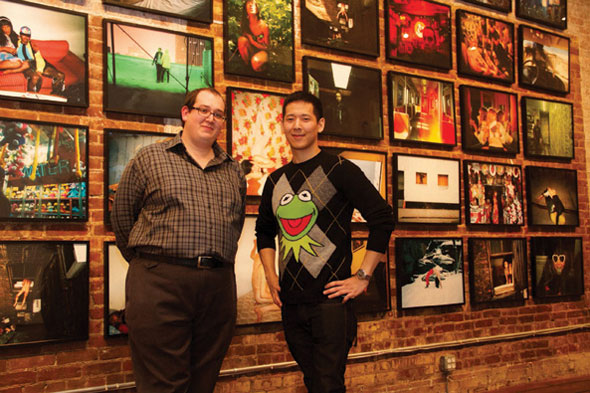gallery
High Art, Young Dudes
A temporary space for the next generation
by Alyson Krueger / GSAS ’12
Walking into TEMP, a new art space in Tribeca that promotes young talent, one can’t help but think: This is different.First, there is the art—all made or curated by up-and-comers under the age of 30—which is sometimes hard to distinguish inside the cavernous two-story, 4,500-square-foot space of exposed brick and iron piping. On a recent visit, a patron helped explain that the video of the sleeping girl on the train was art, but the bicycle in the corner was just someone’s ride. And the crowd of early twentysomethings dressed in thick glasses and hoodies is a far cry from the cliché image of “uptown” gallery regulars. Finally, there are TEMP’s 24-year-old founders, Ari Lipkis (CAS ’11) and Alex Ahn (CAS ’11), who are as eccentric as their exhibits. Lipkis, a smiley, bow-tie wearing Manhattan native, and his colleague, Ahn, a petite Los Angeleno, run around hugging visitors warmly and giggling.

If all TEMP did was display the work of young artists, it would stand out. The financial and reputational risks of taking on untried artists are so high that most institutions simply don’t do it. But Lipkis and Ahn go even further by offering unknowns the opportunity to curate exhibitions and produce shows. At its core, TEMP gives the “nameless” artist a forum to strut.
And people are noticing. Artinfo, an online guide to what’s hot in art, has featured TEMP twice. The Huffington Post declared: “Here’s betting on a Chelsea satellite location when these kids hit 30.” And Lipkis and Ahn were giddy last fall because an art critic from The New York Times had just been in touch. The Independent Curators International and the Contemporary Arts Centre, the largest art hub in the Baltic states, have worked with the gallery on exhibitions, and scholars such as Julia Robinson, who teaches art history at NYU, are invested in helping TEMP grow their network. “What is really great about the art world is that it is very much a community,” Ahn says.
TEMP was born out of Lipkis and Ahn’s post-graduate frustration. They both majored in art history at NYU and co-chaired the Fine Arts Society, which organized behind-the-scenes looks at the city’s most prestigious art spaces. But once they finished school and got jobs—Lipkis as an aide to an independent art collector and Ahn as a member of a tech start-up in Dumbo—they found themselves, like many of their friends, too insignificant in the industry to have any impact. So over a drink, the duo decided to stop “bemoaning the difficulty of being young in the art world,” and to do something bold.
Fortune struck when a family friend of Ahn loaned them the space to use for a year (hence the name, TEMP). Paying no rent and using personal savings, they quit their jobs and taught themselves the basics of installing artwork and drafting legal contracts. The NYU art scene network then helped them find plenty of options for their first exhibition, “Working On It,” which opened last fall and showcased 12 artists chosen “because their art reflected the new culture of today,” Ahn says. The show’s inventory made it clear that no one style or subject defines the new generation. One wall featured Dean Levin’s “So Series,” which offered pastel-colored word bubbles with phrases such as So Chill!, So Down!, and So Cool! The opposite wall featured Sandy Kim’s expressive photos of, among others, a naked woman with Xs taped across her nipples.
TEMP’s next show consisted of mini exhibitions set up by contemporary arts collectives across the world, including Videotage (Hong Kong), Matadero Madrid, and the Raw Material Company (Dakar). Not surprisingly, young artists and curators have rushed in as word has spread about the experiment, so finding new talent isn’t an issue. The better question is what happens this August when TEMP is scheduled to shut its doors. Ahn is hopeful that the ride isn’t over. “Maybe there will be a TEMP 2,” he suggests. “Or maybe the landlord will be generous and let us extend our lease.”







